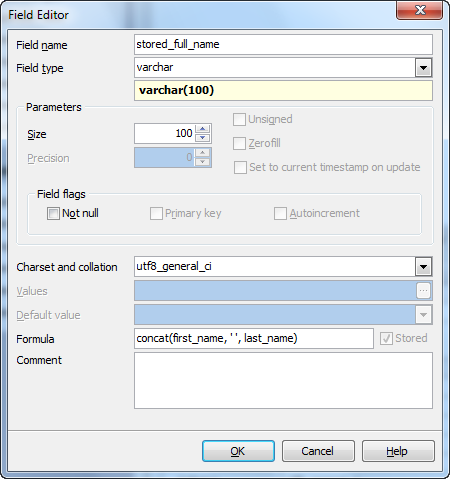SQL Maestro for MySQL online help
| Prev | Return to chapter overview | Next |
Fields
Table columns are created and edited within the Field Editor.
To add a new table column, you should either:
or
or
|
Table fields are edited within the Field Editor dialog window. In order to open the dialog you should either
or
You can change the name of the field using the Rename Field dialog. To open the dialog you should either
or
|
To drop the table field:
or
and confirm dropping in the dialog window.
|

To specify the Data Type, select it from the drop-down list or complete the appropriate field manually in case of data type lacking in this list.
Note: the name of the object must be unique among all the object names in the table. You can use any identifier that is allowed by MySQL server.
Parameters
Use the Size edit box to define the length of the field value for integer, float, char and other data types and use Precision to define the precision of the field value, e.g. for float data type.
Field flags
 Not Null
Not Null
Forbids the NULL values for the field.
 Unique
Unique
Includes the field into the unique key (index).
 Primary Key
Primary Key
With this option checked the field becomes the only field with a primary key. If you check this field, you will not be able to set this attribute for any other field in the table. Hence if you want to create a compound primary key, do not check this field but create a primary key through the Indexes tab of Table Editor or the appropriate step of Create Table Wizard.
 Autoincrement
Autoincrement
For MyISAM tables you can specify the option on a secondary column in a multiple-column index. In this case, the generated value for the Autoincremented column is calculated as MAX(auto_increment_column) + 1 WHERE prefix=given-prefix. This is useful when you want to put data into ordered groups.
 Invisible
Invisible
Check the box to hide the column for queries (MySQL 8.0.23+ | MariaDB 10.3.3+).
 Zerofill
Zerofill
Check the box to set the default padding of spaces will be replaced with zeros. For example, for a column declared as INT(5) ZEROFILL, a value of 4 is retrieved as 00004.
Note: The attribute is stripped when a column is involved in expressions or UNION queries.
Note: If you specify the option for a numeric column, MySQL automatically adds the Unsigned attribute to the column
 Unsigned
Unsigned
If specified, disallows negative values. For example, if the signed range is -128 to 127 the unsigned range is 0 to 255.
 Set to current timestamp to update
Set to current timestamp to update
This option is available for timestamp fields (all MySQL versions) as well as for datetime fields starting from MySQL 5.6.5. An auto-updated column is automatically updated to the current timestamp when the value of any other column in the row is changed from its current value.
Specify the column character set and collation.
Formula
Expression to compute the value of generated columns. If the stored checkbox is turned ON, the value of the column will be persistently stored in the database.
Default value
Within the box you can assign a default value for the field column. The action is optional. If the default value was specified during the new row created and no values is specified for some of the columns, the columns will be filled with their respective default values.
The Comment box allows you to set optional text describing the field.





 Download
Download Buy
Buy